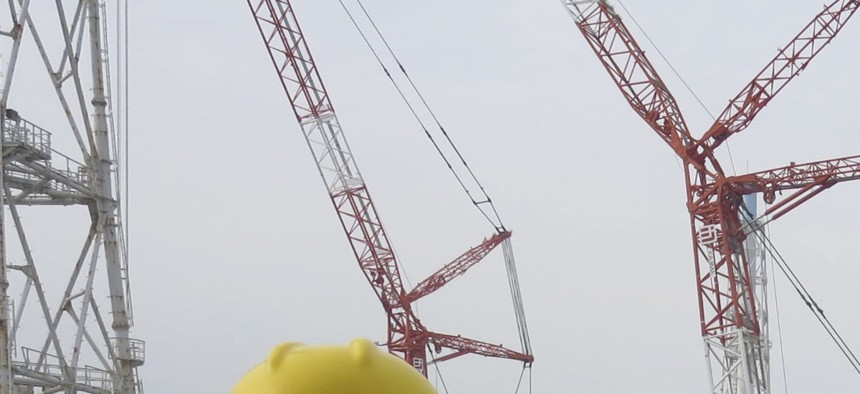Does U.S. Advice on Disposing Fukushima Waste Apply Back Home?

an International Atomic Energy Agency team wearing protective gear inspects the fuel storage pool of the No. 4 reactor building at Fukushima Dai-ichi nuclear power plant. AP
Critics worry feds may be looking to relax rules.
A presentation the U.S. Environmental Protection Agency made to Japanese officials dealing with the aftermath of the Fukushima power plant disaster is adding to critics’ concerns that the federal government may be looking to relax disposal rules for the type of radioactive waste a nuclear attack or accident in the United States could generate.
In recent months, watchdog groups, along with some state-government agencies, have been raising concerns over language in a new EPA guide for dealing with the aftermath of such an incident.
The so-called “protective action guide,” which the agency is accepting public comments on through Monday, suggests it may be necessary to dispose some radioactive waste in conventional landfills rather than in nuclear waste-specific facilities built pursuant to Nuclear Regulatory Commission rules.
The disposal issue is one of several concerns that activists and some state officials have with the document, which is meant to give advice to federal, state and local officials following a broad range of radiological incidents -- such as "dirty bomb" attacks, nuclear power plant meltdowns and industrial accidents. The guide is also creating controversy for suggesting that standards for drinking water and long-term cleanup could be relaxed after such incidents.
EPA officials have argued in statements to the press that they are not looking to retreat from their conventional rules, but critics say other agency documents obtained by Global Security Newswire suggest otherwise.
The documents, some of which the agency released to GSN under the Freedom of Information Act, suggest agency officials are advocating for cleanup and disposal procedures that ordinarily would not be permitted in the United States, critics say. They fear language in the new EPA response guide could enable such exceptions to the normal rules.
In the United States, materials that have become radioactively contaminated normally cannot be categorized as anything less than “low-level radioactive waste,” or “LLRW,” a distinction that requires disposal at tailor-made nuclear-waste sites designed to prevent the release of radiation into the environment.
A May 2012 EPA presentation to Japanese officials grappling with the aftermath of the Fukushima disaster suggests, however, that some contaminated debris could be classified as “very low-level waste,” or “VVLW.”
Such a category does not exist in the United States, but International Atomic Energy Agency guidance documents describe it as one that would allow some radioactive waste to be subject to less stringent disposal regulations than LLRW materials -- a prospect that environmentalists in the United States have long opposed and argue is not accepted by U.S. policy.
The May presentation was led by John Cardarelli, an official in the EPA emergency management office who has led the agency’s efforts to assist the Japanese since the onset of the Fukushima crisis in 2011.
It suggests that some lesser-contaminated materials could even be deemed “non-radioactive waste” and therefore become eligible for recycling, potentially for use in consumer products, which critics also argue is currently illegal in the United States.
In a statement provided to GSN, the agency says the presentation was meant to “broadly discuss options for possible consideration for the Japanese in the aftermath of Fukushima.” It nonetheless defends the disposal and recycling options offered in the presentation, suggesting they are backed by U.S. government and industry officials.
The American National Standards Institute -- a private organization whose members include the Nuclear Energy Institute and other nuclear industry groups -- supports the idea that some contaminated items should receive “clearance” from all regulation in a 1999 report, according to the EPA statement, provided to GSN by agency spokeswoman Julia Valentine.
In addition, the U.S. Nuclear Regulatory Commission “does specify exempt and unimportant quantities of radioactive material in [its] regulations,” the EPA statement asserts.
Further, the prospect of recycling certain radioactive materials in the United States “has been discussed and analyzed over the years,” most recently in a draft environmental assessment by the Energy Department that contemplates lifting a ban on recycling radioactive scrap metals, the agency says.
“Nearly all soil and materials have some amount of naturally occurring and/or anthropogenic radioactivity associated with it,” the EPA statement argues. “At some point a contaminant will be present in a media where it is not a significant risk or dose contributor, either on its own or compared to other naturally occurring anthropogenic contaminants.”
Daniel Hirsch, a nuclear policy lecturer at the University of California-Santa Cruz, says the EPA argument is contrary to U.S. policy.
Federal policy “doesn’t say there is a contaminant at a level where there is not a significant risk and we can therefore ignore it,” he said. “Current law says that anything that’s radioactive has to be disposed of appropriately.”
Hirsch called the American National Standards Institute report the agency cited “a proposal by industry” that is “at variance with the EPA policy [that Cardarelli] is sworn to carry out.” In addition, the agency’s claim that the Nuclear Regulatory Commission already allows some radioactive waste to be disposed outside of purpose-built facilities is misleading, he said.
The commission -- which primarily deals with commercial power plants and some research reactors and medical facilities -- has opted not to regulate certain items containing radioactive elements such as luminous watch dials and gas lanterns. However, U.S. policy does not grant the type of broad exemptions that would allow materials contaminated with radioactive substances from a nuclear-power-plant meltdown or radiological attack in conventional landfills not specifically created for nuclear waste, Hirsch argues.
The commission has a rule that permits nuclear power plants to apply for exceptions, but it is rarely used, said Hirsch. As president of the watchdog group Committee to Bridge the Gap, he currently is involved in litigation aimed at preventing radioactive waste from a meltdown at the DOE Santa Susana Field Laboratory in California from being recycled or sent to conventional dumps.
Past NRC proposals to create a waste category “below regulatory concern” that would be subject to less stringent rules was rejected by Congress in the Energy Policy Act of 1992, he noted.
Meanwhile, the pending environmental assessment by the Energy Department cited in the EPA statement, which contemplates lifting a ban on recycling radioactive scrap metals, has yet to be adopted by the department and so far is facing broad opposition. It is opposed by not only public health activists, but also the recycling industry.
If the type of radioactive materials the department is considering deregulating “enter the scrap supply stream, they would make their way to metal recycling facilities where they would disrupt mill operations, contaminate the mill, impose significant response costs and potentially expose workers and the public to radiation,” the Metals Industry Recycling Coalition says in February comments on the DOE proposal.
The EPA statement says that Cardarelli’s presentation to Japanese officials was meant to “generally discuss waste classifications in the international context.” But the suggestions in it -- along with the agency’s defense of them -- causes concern over the type of practices the government might allow under the new nuclear-response guide, said Hirsch.
“Why would EPA go in to make a presentation on what others do?” said Hirsch. “They’re supposed to be making a presentation on what we do. If you’re going to say something that violates the U.S. policy, you should say so.”
The new disaster-response guide that EPA issued in April does not go as far as to recommend recycling of radioactive materials, but suggests in some circumstances that the sheer volume of waste may force state and local governments to dispose of it in conventional landfills.
This idea is being opposed by state and local officials in California and Pennsylvania, on the grounds that only the federal government has the authority to dispose of radioactive waste -- and only at purpose-built sites.
Editor’s Note: This is the second story in a two-part series on issues related to the new EPA response guide.






